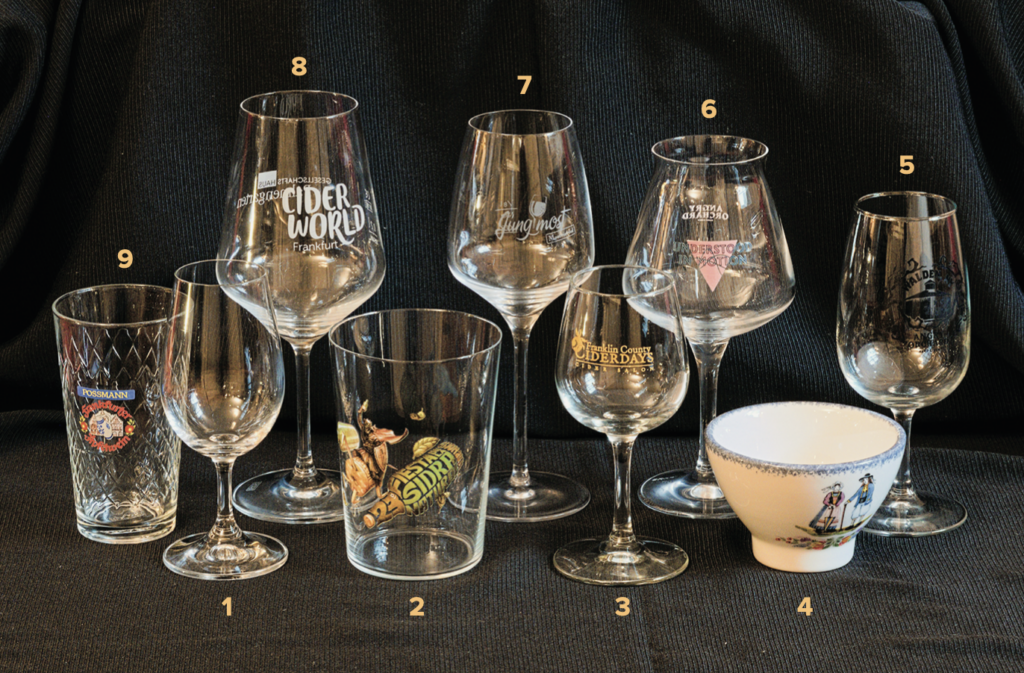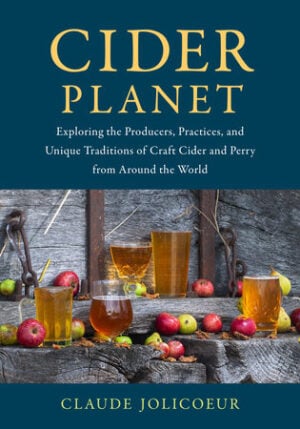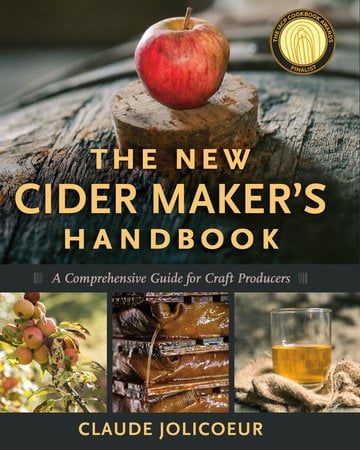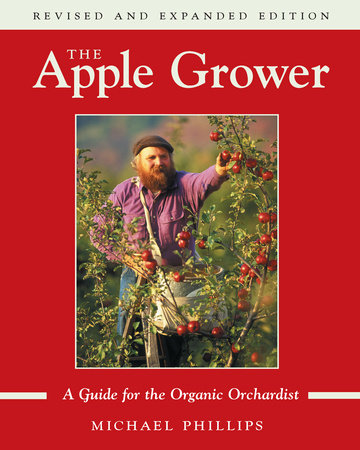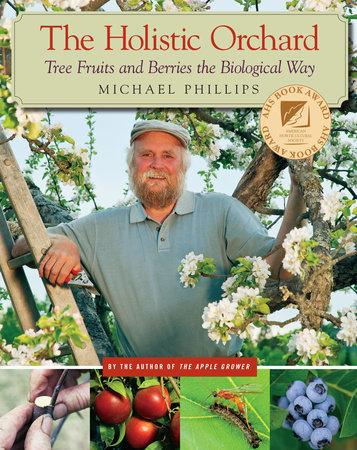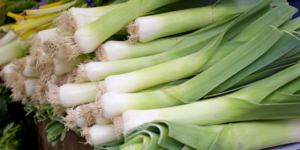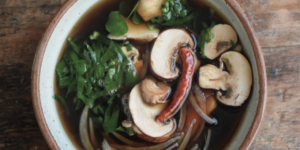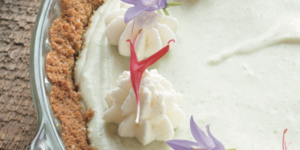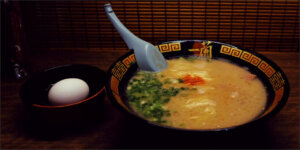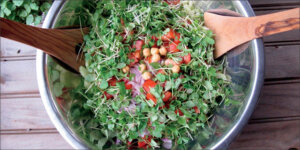Best Types of Glasses for Cider: Let’s Raise A Glass!
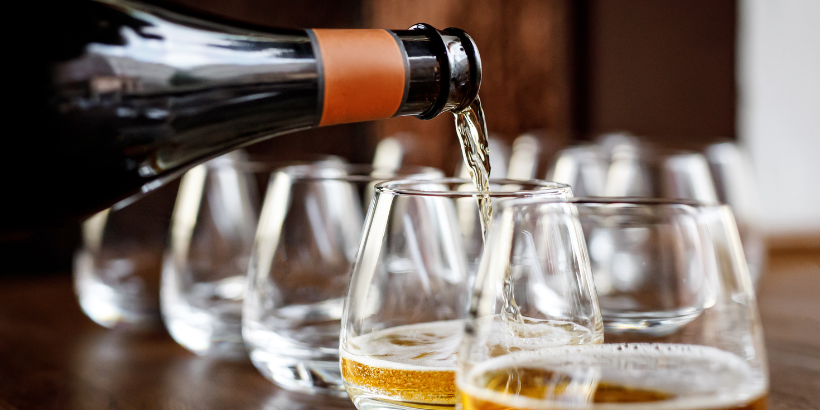
We’d like to propose a toast…to cider! It’s time to push aside those basic cups in the cabinet and make room for some real glasses for cider. Below are some from Claude Jolicoeur’s very own collection.
The following is an excerpt from Cider Planet: Exploring the Producers, Practices, and Unique Traditions of Craft Cider and Perry from Around the World by Claude Jolicoeur. It has been adapted for the web.
Glasses for Cider
Recently, a cider producer friend asked my advice about cider glasses, as he wanted to choose a model of glass for tastings at his cidery. This made me think about all the types of glasses that I have used to drink cider—and there are quite a few. I made a picture of some glasses from my personal collection which, although not complete, does show the diversity that exists. We can see in [the] figure [below]:
- The INAO glass was created by the Institut national de l’origine et de la qualité as a standard tasting glass for wine. It is the most common type of glass used in cidery tasting rooms all over the Cider Planet. It is also used for judging at cider competitions. This glass works well for cider, although it is a bit small, and some find it old-fashioned.
- The Spanish traditional glass for sidra (see chapter 4). This particular one is decorated for the Fiesta de la Sidra.
- The CiderDays’ “Cider Salon” glass is used for the tastings at the CiderDays festival in Massachusetts. It is in fact a fairly standard wine glass that also works well for cider.
- This small bowl is traditionally used for farm cider in Brittany, where we talk about une bolée de cidre. Its usage is now less common, as people often prefer more modern glasses.
- This tasting glass from Angry Orchard in Walden, New York, is a shape somewhat similar to the INAO glass, but slightly larger.
- Another glass from Angry Orchard, this model is intended to go with their Understood in Motion series of high-quality ciders. The shape is that of the renowned Teku beer glass, which is also used for cider service at the Joran Cidrothèque in Brussels.
- The Austrian tasting glass, selected by the Most Barons and used by most cideries in the Mostviertel region (see chapter 8), is a beautiful glass. A similarly shaped glass is used for service at Le Sistrot, a cider bistro in Quimper, Brittany.
- This glass is used for tasting at the CiderWorld fair in Frankfurt. I find it is a bit large for a cider glass.
- The Gerippte is the glass for serving traditional Apfelwein in Germany (see chapter 5) and used in all cider bars in Frankfurt. These are available in two sizes, 250 and 300 mL (8.5 and 10 oz.), the one pictured being the smaller size.
I wish to make it clear to the reader that I am no specialist on glasses. The main point that I want to make here is that there is yet no standard established for a cider glass, as we can see that all sorts of shapes and sizes are used—although some are traditional to a given region. If there is one type that may eventually emerge as a “standard cider glass,” in a similar way as we have standard glass shapes for red wine, white wine, beer, and so on, I’d take a guess it would be based on the INAO tasting glass but slightly larger, somewhat like glass #5 in the photo. In effect the INAO glass has a full capacity of approximately 200 mL (7 oz.), and many find it a bit too small because it should be less than half filled when tasting.
For example, at Le Sistrot, the standard serving for a glass of cider is about 120 mL (4 oz.), and this is too much for the INAO glass, which would then be more than half-filled. I can, however, see that glasses with similar shapes and proportions but with a capacity of 300 to 350 mL (10 to 12 oz.) would become a favorite for the service of cider. It should be noted that some manufacturers of fine glassware are starting to add cider glasses to their collections, and it will be interesting to see what they come up with.
You may ask which are my favorites from those in the photo? Well, I’d say the INAO tasting glass (#1) is probably the one I use most often for daily cider drinking, closely followed by the CiderDays “Cider Salon” glass (#3). However, my favorite is the Austrian glass (#7) for its elegance and delicacy, but since I don’t want to break it I use it only on special occasions! What I have experienced is that a good cider will taste good in just about any glass, and a bad cider won’t become good if served in a great glass. But, a nice glass does add a little something special, the pleasure of drinking in a quality glass, and this is not negligible. We can add that pleasant company and a good story about the cider or the apples also increase the pleasure of drinking…..
Recommended Reads
Recent Articles
How did the modern leek become what it is today? On his quest to save our heritage produce, Adam Alexander unveils the complex history behind leeks and many other vegetables.
Read MoreSoup Lovers Rejoice! Ditch the ordinary chicken noodle and tomato bisque. We’re shaking things up with game-changing soups and a secret ingredient… Vinegar! Ready to level up your soup game?
Read MoreIntroducing our show-stopping spruce tip key lime pie. Spruce up your next gathering with our easy & impressive spruce tip key lime pie. Simple yet delicious!
Read MoreWarm up with a bowl of soul-healing miso soup! Not only delicious, but also packed with amazing health benefits. Add your own twist to this humble base.
Read MoreDoes the cold weather have you dreaming about fresh greens and colorful salad? Tired of waiting for spring to enjoy fresh greens? Grow and harvest sprouts indoors to make those dreams a reality!
Read More

